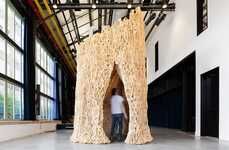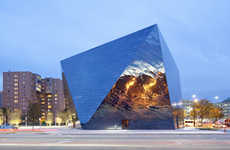
The BIQ House Generates Both Energy and Shade for Those Residing Inside
Meghan Young — October 24, 2012 — Eco
References: splitterwerk.at & psfk
The BIQ house is a natural progression from buildings covered in vertical gardens. While its predecessors were decorated as such for looks and an environmentally conscious statement, the BIQ house uses energy generated from the algae covering it to provide power as well as shade for those residing inside.
Designed by Splitterwerk Architects, in collaboration with Colt International, Arup, and SSC, for the International Building Exhibition in Hamburg, Germany, the BIQ house is set to become the first real-life test for bio-adaptive façade systems. Due to be completed in March 2013, the BIQ house will grant scientists, engineers and builders the opportunity to access how well a system like this will work. Jan Wurm of Arup notes, "It also creates a visually interesting look that architects and building owners will like."
Designed by Splitterwerk Architects, in collaboration with Colt International, Arup, and SSC, for the International Building Exhibition in Hamburg, Germany, the BIQ house is set to become the first real-life test for bio-adaptive façade systems. Due to be completed in March 2013, the BIQ house will grant scientists, engineers and builders the opportunity to access how well a system like this will work. Jan Wurm of Arup notes, "It also creates a visually interesting look that architects and building owners will like."
Trend Themes
1. Bio-adaptive Façades - The use of algae to generate energy in façade designs is a trend that promises energy-efficient, environmentally friendly and visually stunning building styles.
2. Sustainable Architecture - A trend that is turning toward environmentally sustainable architecture, where designs incorporate features that naturally contribute to cleaner living, carbon neutrality, and reduced greenhouse gas footprints.
3. Energy-generating Façades - A trend, where new ones of energy such as algae are used to generate renewable energy in façades, which reduces dependence on the grid and fossil fuels.
Industry Implications
1. Construction - Construction industries can take advantage of this technology to lower the cost of their operations and improve the quality of their designs.
2. Architecture - Architecture industries can take advantage of this technology to design buildings that are energy-efficient, environmentally friendly, visually stunning, and cheaper to erect.
3. Energy - Energy industries can take advantage of this technology to harness and store clean energy and reduce reliance on fossil fuels, resulting in a more sustainable energy future.
4.6
Score
Popularity
Activity
Freshness























